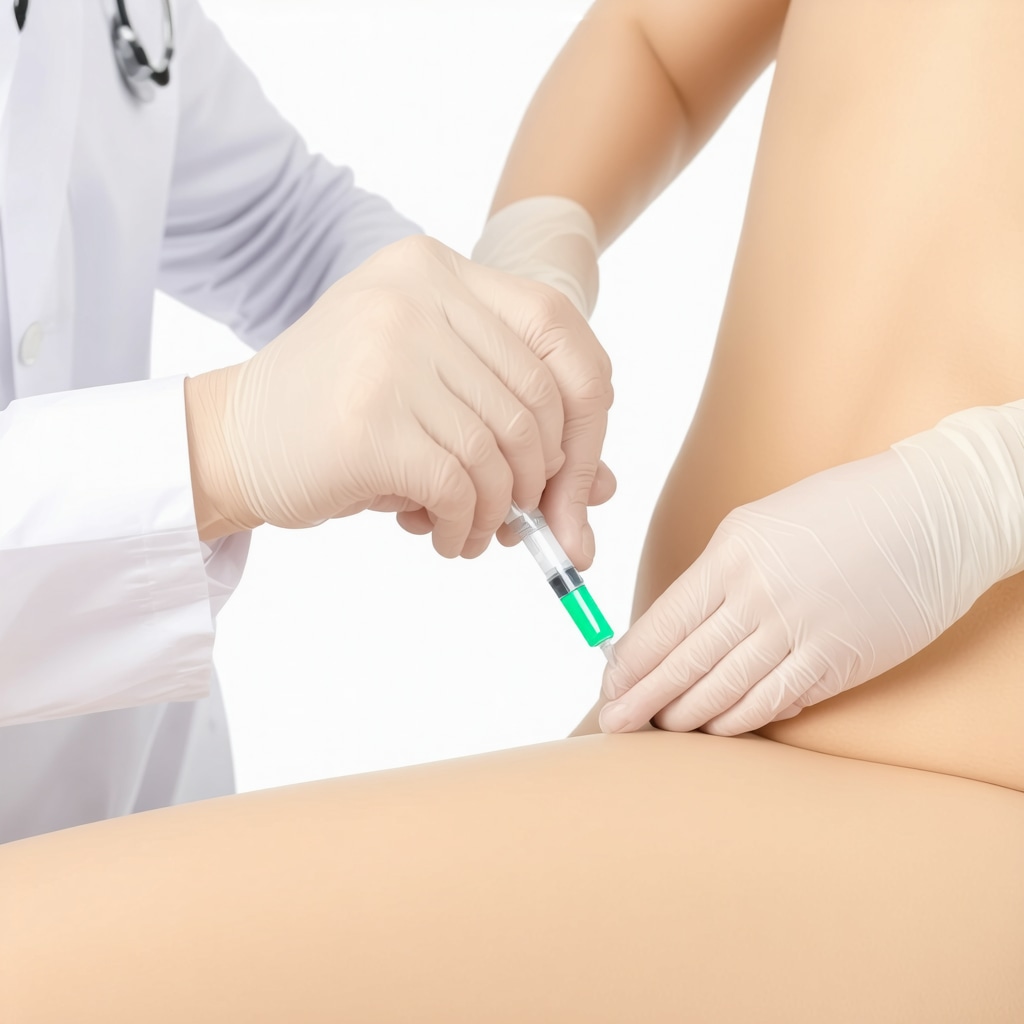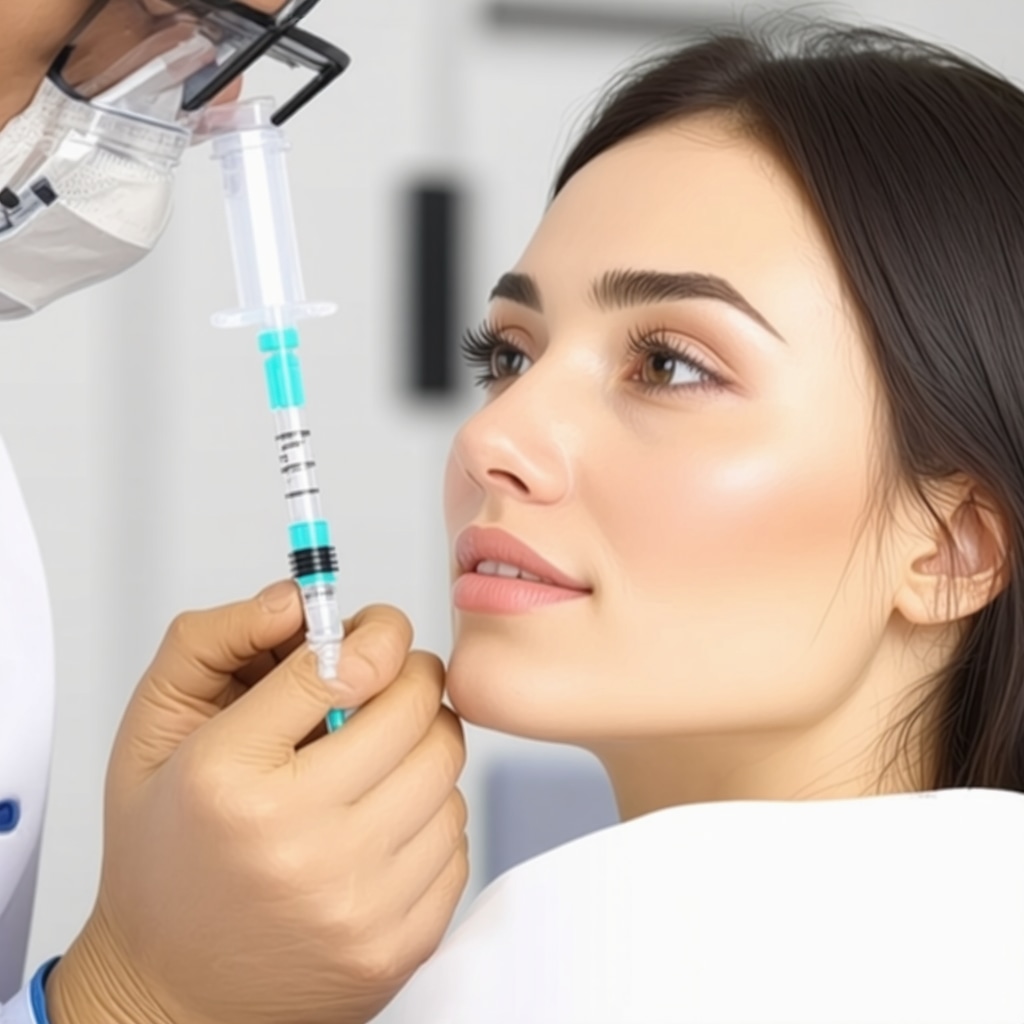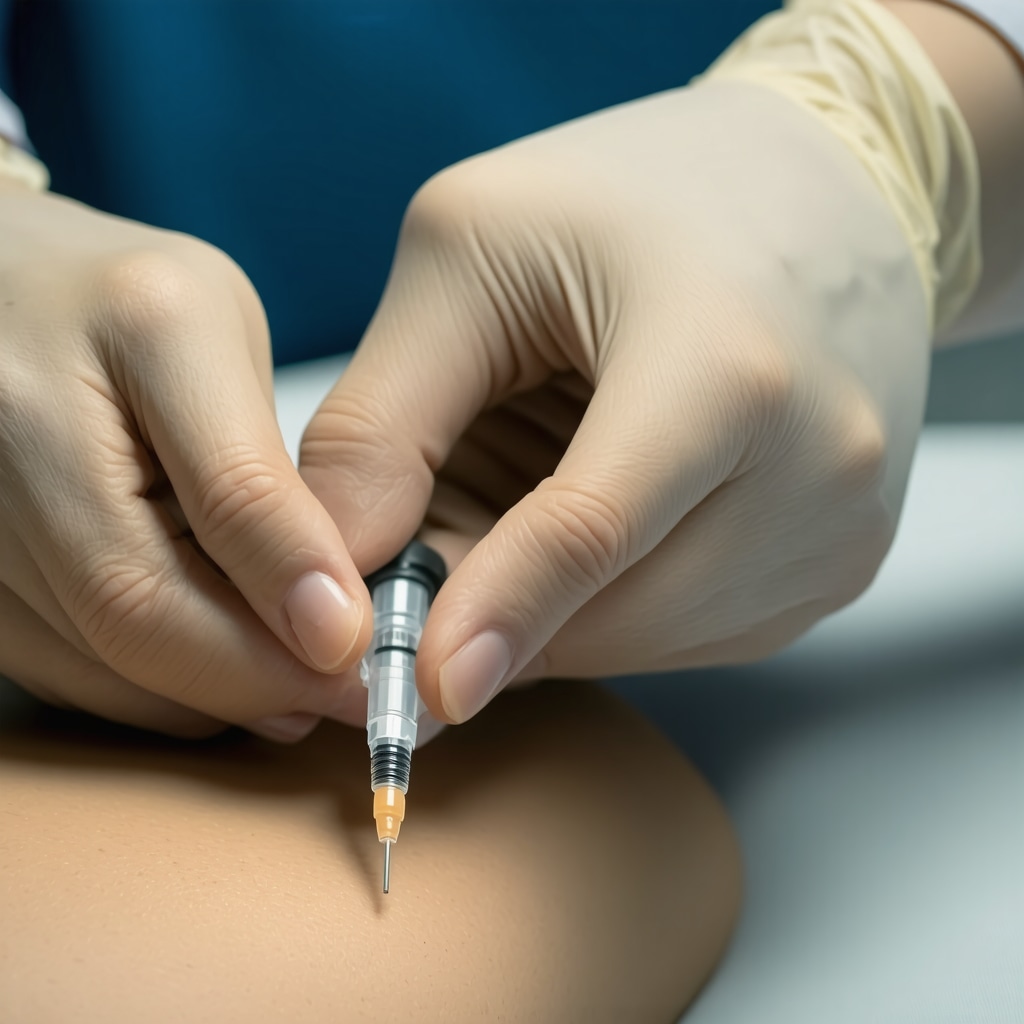Unlocking the Secrets Behind Doctor-Supervised Ozempic Injections
If you’ve ever wondered why some weight loss journeys feel like an uphill battle while others glide smoothly, the secret might just be in the injection technique. Ozempic, the once diabetes-focused medication that has taken the weight loss world by storm, demands more than just a prescription—it demands precision. Under the watchful eye of a medical professional, the nuances of administering Ozempic turn from intimidating to empowering.
Why Does Injection Technique Matter More Than You Think?
Let’s face it: nobody enjoys needles, but the way you inject Ozempic can be the difference between a smooth experience and a rollercoaster of side effects. Doctor-supervised treatments ensure that patients learn the correct subcutaneous method—injecting into the fatty tissue just beneath the skin, typically in the abdomen, thigh, or upper arm. This isn’t just a matter of convenience; it’s about maximizing absorption and minimizing discomfort.
Is There Really a “Right” Way to Inject Ozempic or Is It All Just Fear of Needles?
Great question! The truth is, while the needle is tiny and the dose minuscule, technique matters. A too-shallow injection can lead to irritation or inconsistent dosing, while injecting into muscle tissue may increase unwanted side effects. This is why doctor supervision is invaluable—it’s not merely about sticking a needle in but mastering the art of self-care in a very literal sense.
Many patients find that rotating injection sites, as advised by their healthcare provider, helps prevent skin lumps known as lipohypertrophy—a common but avoidable hurdle. Plus, watching a professional demonstrate proper technique can alleviate anxiety and foster confidence, turning what could be a dreaded moment into a routine act of empowerment.
Injecting Confidence: The Role of Medical Guidance
Doctors don’t just hand over a prescription and wave goodbye. Instead, they offer ongoing support, adjusting dosage schedules and addressing concerns about side effects or injection discomfort. This doctor-patient partnership is crucial for sustained success and safety. Curious to dive deeper? You might find value in exploring safe injection practices under doctor supervision to get the full scoop.
And if you’re wondering about how Ozempic stacks up against other GLP-1 drugs in 2024, the Ozempic vs. Wegovy showdown might just be your next read.
Want to Share Your Ozempic Injection Story?
Whether you’re a seasoned Ozempic user or just starting your weight loss journey, your experience with injection techniques matters. Drop a comment below or share your tips and tricks—let’s make this a community of empowered self-care warriors.
For those seeking expert insight, the National Center for Biotechnology Information offers a comprehensive review on GLP-1 receptor agonists, including Ozempic, highlighting the importance of proper administration and adherence to treatment protocols.
Fine-Tuning Your Ozempic Injection Routine for Maximum Effectiveness
While the basics of Ozempic administration are essential, expert patients and clinicians alike know that small adjustments can make a substantial difference in outcomes. Understanding how timing, diet, and even hydration interplay with injection schedules can elevate your weight loss journey from average to exceptional. For example, injecting Ozempic at a consistent time each week helps maintain steady drug levels, which supports metabolic regulation and appetite control.
Additionally, combining Ozempic with tailored nutrition plans amplifies fat loss effects. This synergy ensures that the medication’s appetite suppression aligns with nutritional intake, reducing the risk of nutrient deficiencies or rebound hunger that can derail progress.
How Can Patients and Providers Collaborate to Overcome Plateaus in Ozempic Therapy?
Plateaus are a common challenge in any weight loss program, including those using Ozempic. From an expert perspective, overcoming these requires an adaptive approach. Physicians who monitor patient progress closely can make informed decisions about dosage adjustments, supplementary therapies, or lifestyle modifications. For example, adding moderate exercise or tweaking macronutrient ratios can re-energize fat-burning mechanisms.
Patients should also engage actively in tracking their weight loss trajectory, noting changes in appetite, energy, and side effects. This detailed feedback loop facilitates personalized care, as highlighted by medical weight loss clinics specializing in Ozempic therapy. Their expertise ensures that patients don’t navigate these hurdles alone but with a roadmap tailored to their physiology and lifestyle.
Integrating Technology: Tracking Tools for Enhanced Ozempic Weight Loss Success
The digital age offers remarkable tools that complement doctor-supervised Ozempic treatments. Apps designed for medication reminders, food logging, and physical activity monitoring provide a comprehensive picture of the patient’s health status. These tools empower users to maintain adherence and make real-time adjustments when necessary.
Clinicians can also leverage telehealth platforms to conduct regular virtual check-ins, ensuring patients remain supported without the constraints of frequent office visits. This hybrid model of care blends convenience with expert oversight, a critical factor in long-term weight management success. If you want to explore more on how telehealth is revolutionizing access to Ozempic, check out this insightful resource.
According to a recent review by the Journal of Clinical Endocrinology & Metabolism, digital adherence tools combined with physician-supervised regimens significantly improve patient outcomes in GLP-1 receptor agonist therapies like Ozempic, emphasizing the importance of integrated care approaches.

Personalizing Injection Site Rotation: Science Meets Self-Care
Although rotating injection sites is standard advice, the science behind why it matters is fascinating and often underappreciated. Repeated injections in the same spot can cause lipohypertrophy, which not only affects absorption but can also alter the cosmetic appearance of the skin. Understanding the anatomy of subcutaneous fat layers and how they respond to repeated trauma is critical for patients aiming for smooth, consistent dosing.
Medical professionals recommend creating a rotation schedule that balances convenience with tissue health, often mapping out injection zones across the abdomen, thighs, and arms. This practice minimizes local skin complications and preserves the efficacy of each dose. For a detailed guide on safe injection practices, visit this comprehensive article.
Strategic Injection Site Rotation: Leveraging Anatomy for Optimal Ozempic Absorption
Delving deeper into the science behind injection site rotation reveals a nuanced interplay between tissue physiology and pharmacokinetics. The subcutaneous fat layer, where Ozempic is administered, varies in thickness and vascularity across different body regions, influencing the speed and consistency of drug absorption. For instance, the abdomen typically offers a richer blood supply compared to the thigh or upper arm, resulting in marginally faster uptake. Expert clinicians emphasize tailoring injection site choices to individual patient anatomy and lifestyle factors, rather than a one-size-fits-all approach. This personalization ensures that drug plasma levels remain stable, thereby optimizing therapeutic effects and minimizing variability in appetite suppression.
Moreover, repeated trauma to the same site not only predisposes to lipohypertrophy but can also induce localized inflammatory responses that alter tissue permeability and insulin receptor sensitivity. This could theoretically impact the pharmacodynamics of Ozempic, underscoring the critical need for meticulous site rotation. Creating a detailed injection map, sometimes aided by digital tools, helps patients visualize and adhere to rotation schedules effectively.
How Does Repeated Injection Site Trauma Influence Long-Term Treatment Outcomes with Ozempic?
Chronic injection site trauma can lead to fibrotic changes within subcutaneous tissues, potentially reducing drug absorption efficiency and causing inconsistent glycemic and appetite control. This phenomenon, documented in peer-reviewed endocrinology literature, suggests that patients experiencing unexplained fluctuations in treatment response should be evaluated for lipohypertrophy or related tissue alterations. Adjusting injection practices under medical supervision can restore optimal drug kinetics and enhance overall efficacy.
Recent studies, including those published by the Endocrine Society, advocate for proactive patient education on site rotation and regular tissue assessments during follow-up visits to preempt these complications.
Innovations in Injection Site Care: Beyond Rotation to Skin Health Preservation
Emerging research highlights adjunctive strategies to preserve injection site integrity and enhance patient comfort. These include the use of topical agents that promote skin elasticity and reduce inflammation, as well as advanced needle technologies designed to minimize tissue trauma. For example, ultra-fine needles and automatic injection devices have been shown to decrease pain perception and improve patient adherence.
Additionally, integrating skin care routines such as gentle exfoliation and moisturizing can maintain dermal health, preventing dryness and irritation that complicate injections. Physicians often recommend these complementary practices as part of a holistic injection site management plan.
Understanding the microenvironment of injection sites and how it evolves with chronic therapy is a frontier in weight management pharmacotherapy, promising to elevate patient experiences and outcomes.
Leveraging Personalized Feedback Loops: Advanced Monitoring Techniques for Injection Site Optimization
The future of Ozempic administration lies in personalized medicine augmented by technology. Wearable sensors capable of detecting tissue changes or inflammatory markers at injection sites are under investigation, aiming to provide real-time alerts to both patients and clinicians. This proactive monitoring could revolutionize how injection protocols are adjusted dynamically, preventing complications before they manifest clinically.
Furthermore, integrating patient-reported outcomes with electronic health records enables a comprehensive feedback system, fostering collaborative decision-making. This aligns with the precision medicine paradigm, where treatment regimens are continuously refined based on individual responses.
Clinicians interested in pioneering these approaches can explore pilot programs and clinical trials through endocrinology research networks.
Ready to elevate your Ozempic injection routine? Engage with our expert-led community to share experiences and access cutting-edge resources designed to empower your journey.

Revolutionizing Injection Site Management: Beyond the Basics to Maximize Ozempic Efficacy
While the foundational principles of injection site rotation and technique are well established, cutting-edge clinical insights suggest that a more nuanced approach to injection site care can profoundly influence Ozempic’s therapeutic impact. Tailoring injection practices based on individual patient physiology and integrating proactive skin health preservation routines are emerging as pivotal factors in sustaining long-term weight loss success.
Understanding the dynamic subcutaneous tissue environment aids clinicians and patients in preventing complications such as lipohypertrophy, which can attenuate drug absorption and lead to erratic appetite suppression. By adopting personalized injection maps and combining them with adjunctive skin care strategies, patients can maintain consistent dosing and reduce discomfort.
For a comprehensive overview of safe and effective injection practices under professional supervision, explore this detailed guide on doctor-supervised Ozempic treatments.
How Can Integrating Advanced Skin Care Protocols Improve Long-Term Injection Site Health for Ozempic Users?
Emerging evidence underscores the importance of skin barrier integrity and local tissue health in optimizing medication absorption. Incorporating gentle exfoliation, moisturizing regimens, and the use of topical anti-inflammatory agents can mitigate chronic irritation and enhance tissue elasticity, minimizing the risk of fibrosis and lipohypertrophy. Additionally, innovations such as ultra-thin needles and automated injection devices are reducing mechanical trauma, thereby improving patient adherence and comfort.
These strategies, coupled with regular clinical assessments, enable a holistic injection site management approach that goes beyond mere rotation schedules. Clinics specializing in medical weight loss and Ozempic therapy are pioneering these integrative care models to bolster patient outcomes.
Furthermore, as the role of inflammation in subcutaneous tissue response becomes clearer, clinicians are exploring personalized topical treatments to preempt injection site complications, a frontier highlighted in recent endocrinology research published by the Endocrine Society.
Harnessing Digital Health: How Telemedicine and Mobile Apps Elevate Ozempic Injection Monitoring and Support
The fusion of telehealth platforms and mobile health applications is transforming the landscape of Ozempic administration. Real-time monitoring tools enable patients to log injection details, track side effects, and receive dosage reminders, fostering rigorous adherence to treatment protocols. This digital engagement complements face-to-face consultations by providing a continuous feedback loop that clinicians can access remotely.
Telemedicine not only facilitates timely dose adjustments and side effect management but also empowers patients through education and emotional support. This hybrid care model is especially beneficial for individuals balancing busy lifestyles or residing in remote areas.
For those curious about integrating telehealth into their Ozempic journey, this resource on telehealth Ozempic prescriptions offers valuable insights into navigating digital weight management solutions.
What Are the Latest Technological Innovations Enhancing Patient Safety and Efficacy in Ozempic Therapy?
Advanced wearable sensors and AI-driven analytics are emerging as powerful tools to detect early signs of injection site inflammation or lipohypertrophy, alerting both patients and providers before clinical symptoms arise. These innovations promise to personalize dosing schedules dynamically, optimizing pharmacokinetics and minimizing adverse events.
Moreover, integration with electronic health records allows for comprehensive data-driven treatment modifications, aligning with the precision medicine paradigm. Ongoing clinical trials are investigating the efficacy of these approaches, signaling a promising horizon for personalized weight loss pharmacotherapy.
Readers interested in staying abreast of these technological advances and expert care models can find further information in our clinicians guide to prescription weight loss with Ozempic.
We invite you to share your experiences or questions about advanced injection site care and digital support tools in the comments below. Your insights enrich our community and help shape the future of safe, effective weight loss strategies.

Expert Insights & Advanced Considerations
Injection Site Physiology Dictates Absorption Dynamics
Understanding the variable vascularity and thickness of subcutaneous fat across injection sites is fundamental for optimizing Ozempic’s pharmacokinetics. Expert clinicians emphasize tailoring site rotation to individual anatomy to maintain stable plasma drug levels and consistent appetite suppression, thereby enhancing therapeutic outcomes.
Chronic Tissue Trauma Undermines Long-Term Efficacy
Repeated injections in limited areas can cause lipohypertrophy and fibrotic changes, reducing absorption and leading to erratic weight loss results. Proactive site rotation combined with skin health preservation protocols is essential to prevent these complications and sustain Ozempic’s effectiveness over time.
Integrating Digital Tools Enhances Treatment Adherence and Personalization
Telehealth platforms and mobile applications empower patients by facilitating real-time injection tracking, side effect monitoring, and direct communication with providers. These technologies create a continuous feedback loop that supports individualized dosage adjustments and reinforces adherence, critical factors in maximizing weight loss success.
Advanced Skin Care Protocols Complement Injection Technique
Adjunctive measures such as gentle exfoliation, moisturizing, and the use of topical anti-inflammatory agents mitigate local irritation and improve tissue elasticity. Combined with innovations like ultra-fine needles and automatic injectors, these protocols improve patient comfort and adherence, directly impacting treatment sustainability.
Physician Supervision Remains the Cornerstone of Safe and Effective Ozempic Use
While self-administration is common, ongoing medical oversight ensures correct technique, appropriate dosage adjustments, and timely management of side effects. This partnership fosters a controlled and responsive approach to weight loss therapy, minimizing risks and optimizing outcomes.
Curated Expert Resources
Endocrine Society Clinical Practice Guidelines: Authoritative recommendations on GLP-1 receptor agonist usage, including injection site management and patient education, essential for clinicians seeking evidence-based protocols. Explore guidelines.
National Center for Biotechnology Information (NCBI) Review on GLP-1 Agonists: Comprehensive analysis of pharmacodynamics, administration techniques, and adherence strategies for medications like Ozempic. Read the review.
WeightLossUppliers.com Doctor-Supervised Ozempic Treatments: Detailed insights into safe injection practices, dosage adjustments, and patient support under medical supervision. Learn more.
Telehealth Ozempic Prescriptions – A New Era in Weight Control: Explores how digital health platforms enhance patient monitoring and improve access to expert care. Discover telehealth innovations.
Clinicians Guide to Prescription Weight Loss with Ozempic: A practical resource outlining best practices for managing injections, side effects, and patient engagement. Access the guide.
Final Expert Perspective
In the evolving landscape of weight loss pharmacotherapy, doctor-supervised Ozempic injections stand out as a sophisticated interplay of precise technique, personalized care, and technological integration. Mastery of injection site rotation grounded in anatomical insight, coupled with proactive skin health management, ensures consistent drug absorption and maximizes therapeutic benefits. The marriage of telehealth innovations and rigorous medical oversight crafts an environment where patients not only adhere to treatment but thrive within it.
For those committed to advancing their understanding or embarking on a physician-guided Ozempic journey, engaging with these expert strategies and resources is invaluable. Share your experiences, ask questions, or explore further expert content to deepen your mastery of this transformative weight loss modality.
Discover how specialized clinics can provide tailored support by visiting best Ozempic clinics for physician-prescribed weight loss and harness the power of digital tools through telehealth Ozempic prescriptions. Your expert journey begins here.

